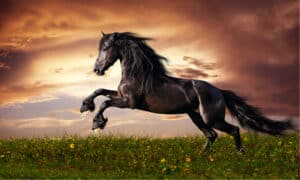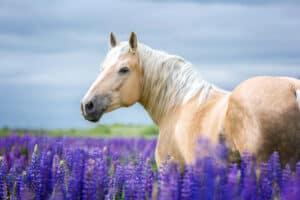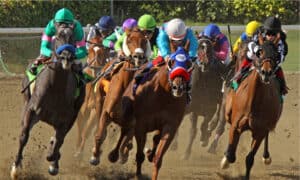If you live or vacation on the coast of North Carolina, you know there are herds of wild horses who live there because you’ve seen them! However, if you haven’t had the pleasure of spotting these animals in their natural habitat, you might be considering a visit to do just that. There are a few things you should know about these wild horses before you come, like how they got here and where exactly they roam. Let’s explore the history of North Carolina’s wild horses and uncover the best places in the state to see them.
History of North Carolina’s Wild Horses
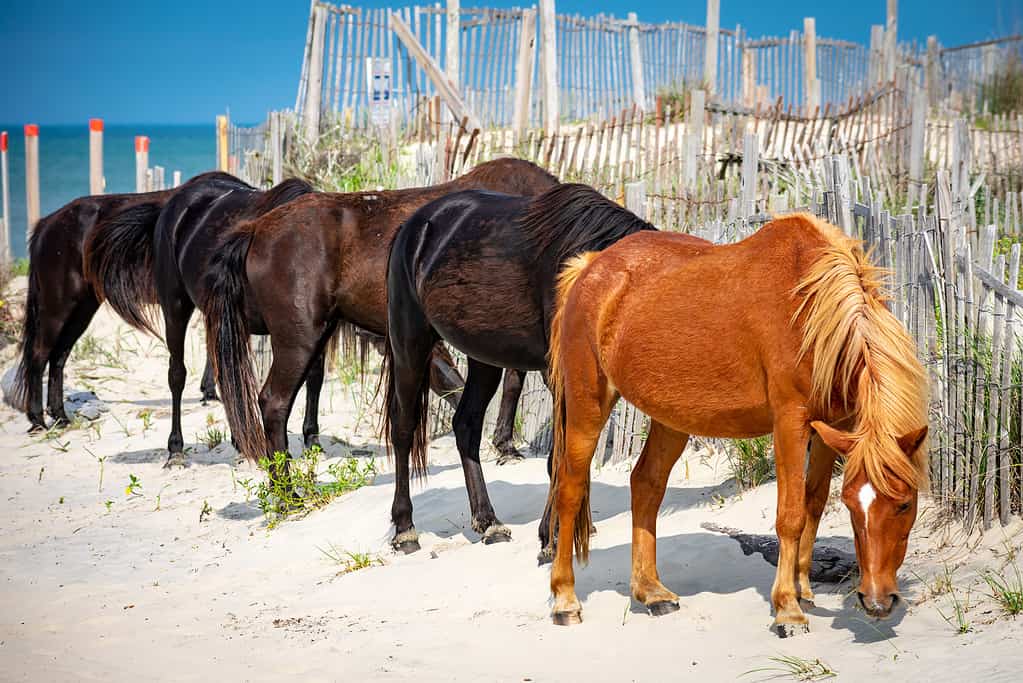
Rumor has it that North Carolina’s wild horses survived a shipwreck in the 16th century that left Spanish Mustangs stranded on the coastal islands.
©Jeff Yount/iStock via Getty Images
The wild horses that live on the East Coast and roam North Carolina’s coastal islands have been there for over 500 years. This is longer than humans have inhabited the region! They survived hurricanes and settlers, continuing to thrive in protected areas of the state and tourist destinations alike.
What are the Wild Horses in North Carolina Called?

North Carolina’s wild horses are all Banker Ponies.
©LembiBuchanan/iStock via Getty Images
The wild horses in North Carolina are all Banker Ponies, thought to be descendants of Spanish Mustangs that the Conquistadors brought to the Americas in the 1500s. Another more likely theory is that they are descendants of domesticated horses left behind by English settlers. Depending on the location of the wild horse, their lineage is either pure Spanish Mustang — like on Corolla — or a mix of domestic stock like Quarter Horses and similar gaited breeds.
However, some island’s inhabitants come with unique names such as the “Ocracoke Ponies” and the “Bankers” on Shackleford Banks and Corolla. These are terms of endearment from locals and the organizations that manage the herds.
North Carolina’s Wild Horse Population
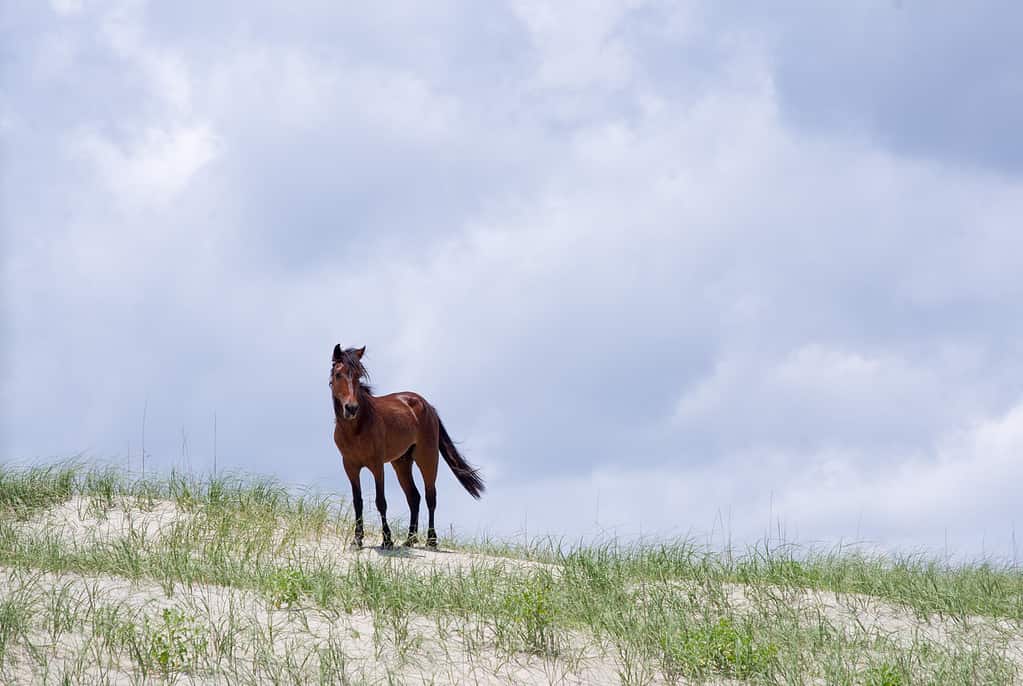
The wild Spanish Colonial Mustang is the state horse of North Carolina.
©BHamms/Shutterstock.com
The wild horse population in North Carolina is thriving thanks to the National Park Service. The NPS manages the herds across the state since they live on nationally protected land. They also work in partnership with the Foundation for Shackleford Horses to manage the herds that live on Shackleford Banks. Additionally, the Corolla Wild Horse Fund and volunteers help protect the horses in Corolla, North Carolina.
How Many Wild Horses Are in NC?
North Carolina’s wild horse population is spread across islands on the coast of the state. Their numbers fluctuate, but around 400 horses roam wild at any given time.
To keep the wild horses healthy and keep their ecosystem in balance, contraceptives are given to certain mares to limit overpopulation. This is done once a year to keep the population within viability for the land.
What Do the Wild Horses in NC Eat?
The state’s wild horse population is hardy and resilient. They have adapted to the coastal living conditions over the past 500 years. Since their nearest water source is the Atlantic Ocean, they have to dig for freshwater or locate freshwater ponds around the islands.
The wild horses’ diet consists of:
- Salt marsh cordgrass
- Sea oats
- Acorns
- Persimmons
- Other native vegetation
It’s important to not feed the wild horses if you decide to visit them. The food and treats we give domesticated horses can make feral horses colic. However, this won’t be a problem if you stay the required 50 feet away from them.
The 4 Best Islands in North Carolina to See Wild Horses
The Outer Banks is an island chain off the coast of North Carolina. A popular vacation destination, it’s known for breathtaking beach views, quaint coastal towns, and an abundance of wildlife including wild horses! But they don’t just roam every area of the state. So where can you see the wild horses of the Outer Banks? Let’s dive into the four most popular islands to spot these stunning animals.
1. Wild Horses of Corolla
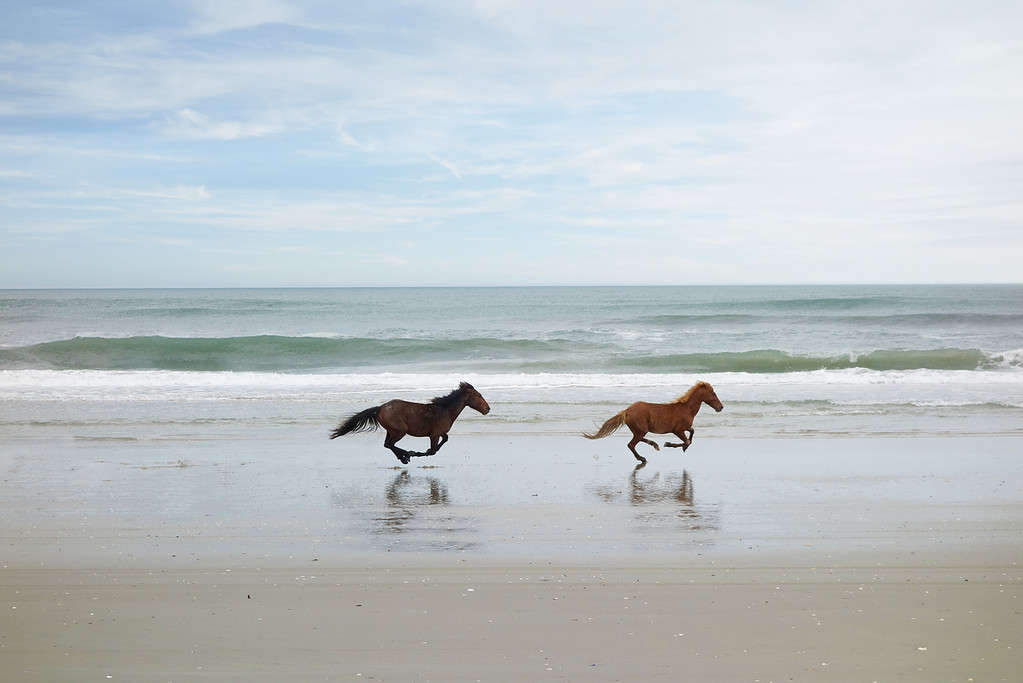
It’s not uncommon to see wild horses running on the beach in Corolla.
©zimmytws/iStock via Getty Images
On the extreme northern end of the Outer Banks lies the barrier island of Corolla. DNA testing done in 1992 and 2007 confirms the wild horses are descendants of Spanish Mustangs who came over hundreds of years ago.
They don’t live in a wildlife refuge or sanctuary, so be prepared to bring a 4WD vehicle, or book a tour if you want to see them. To get a glimpse, visit the northern beaches of Corolla and Carova. The herds live and graze in these areas, so you’ll get to see them in their natural habitat.
2. Ocracoke Island
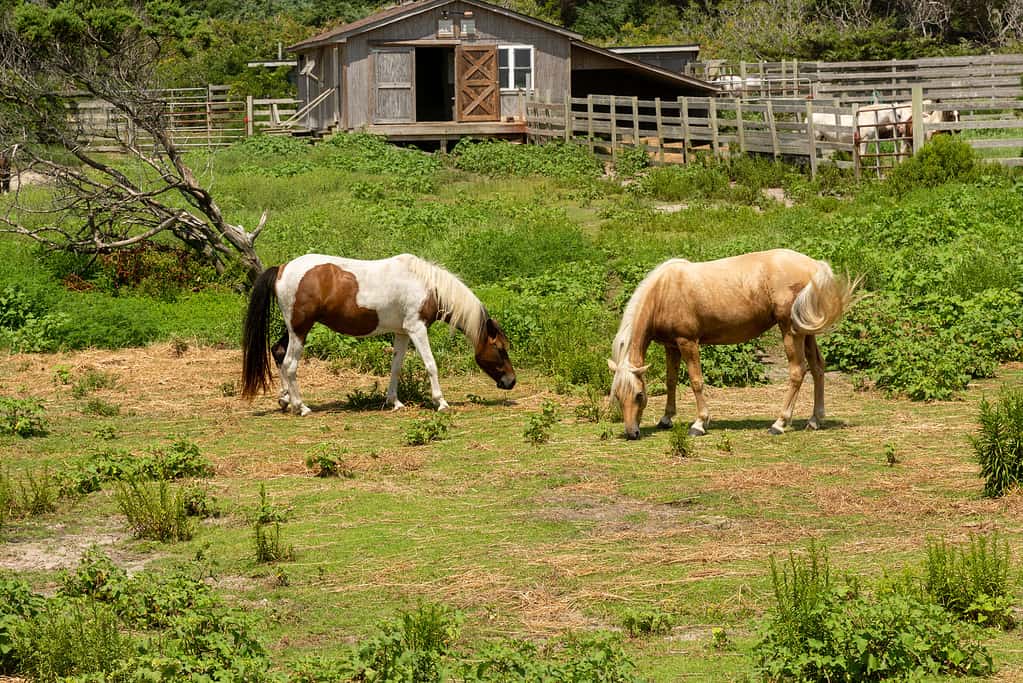
You can see the Ocracoke Banker Ponies at the Ocracoke Pony Pen off Highway 12. The NPS penned them for their protection in 1959 and has kept them safe ever since.
©Liz Albro Photography/iStock via Getty Images
The Ocracoke Pony Pen is one spot where you have a good chance of seeing wild horses on the island. Located south of the Hatteras ferry terminal, you can visit this fenced-in area 24 hours a day. It offers a great vantage point to take in the horses.
Otherwise, your next best bet is to drive along NC Highway 12 and keep an eye on the sound side for a glimpse of the wild horses along the coast.
3. Carrot Island’s Banker Ponies
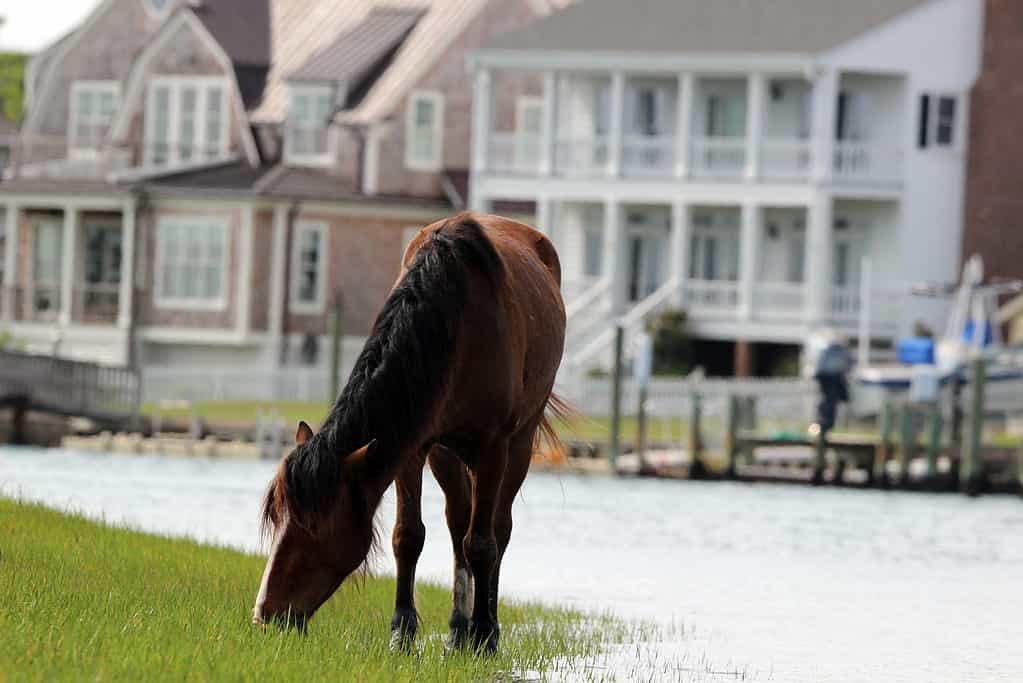
Wild horses have inhabited Carrot Island, which is part of the Rachel Carson Reserve, since the 1940s.
©PamSchodt/iStock via Getty Images
Carrot Island is one of four islands that make up the main part of the Rachel Carson Reserve in Beaufort, North Carolina. The horses here were brought over by a local in the 1940s and became wild soon after. The only way to reach the island today is by boat.
The easiest way to spot the wild horses on Carrot Island is to walk around. They roam freely, so there’s no single location to point to where you’re guaranteed to find them. However, it is possible with the right tide depth to kayak through the marshes of the islands where the horses graze. Talk about a once-in-a-lifetime experience!
4. Shackleford Banks
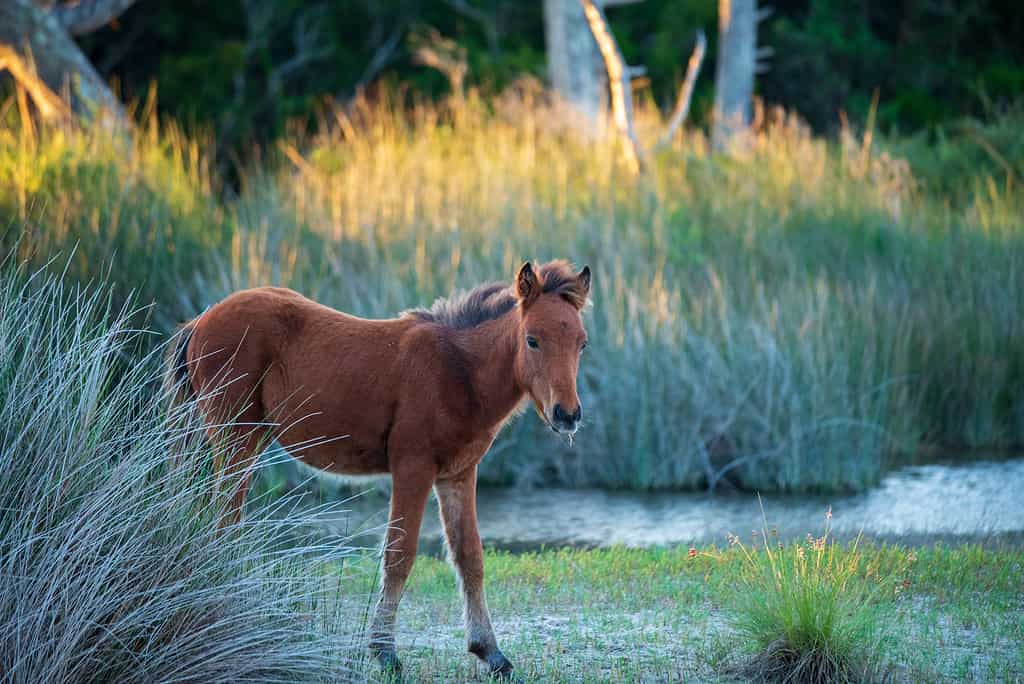
Wild horses, which are the descendants of Spanish Mustangs, still live on Shackleford Banks.
©Penny Britt/iStock via Getty Images
If you visit the southernmost island in the Cape Lookout National Seashore, you can catch a glimpse of the wild horses that live here. You have to take a boat or ferry to reach the barrier island, but it’s worth it.
As of 2022, 124 horses roam Shackleford Banks. You can find them among the dunes, on the shore, or in the marsh grazing. Sometimes they are visible the second you step foot on the island, other times you have to walk around searching for them on the trails. Either way, it’s a treat when you finally rest your eyes on the wild horses of Shackleford Banks.
Best Time of Year to See Outer Banks’ Wild Horses
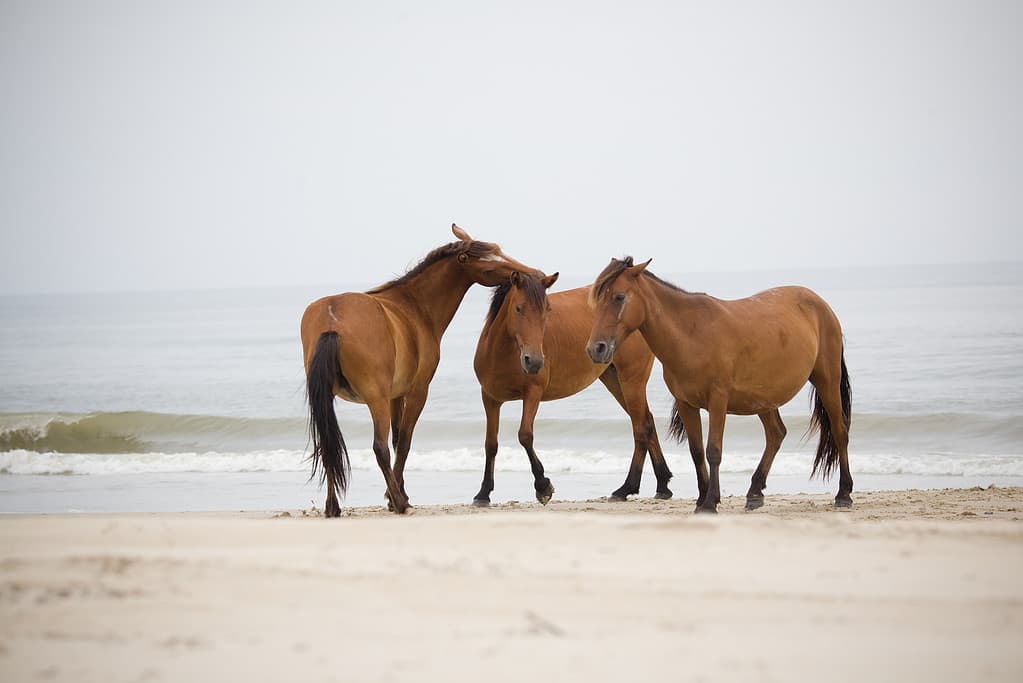
You can see wild horses on the beach in the Outer Banks.
©redskymedic/iStock via Getty Images
The best time of year to come to North Carolina to see the wild horses is during the spring and summer months from April to October.
If you want to spot the wild horses, you’ll likely see them in the early morning or late afternoon. They’re the most active during these times because they are foraging for food and fresh water.
Tours to See the Wild Horses in North Carolina
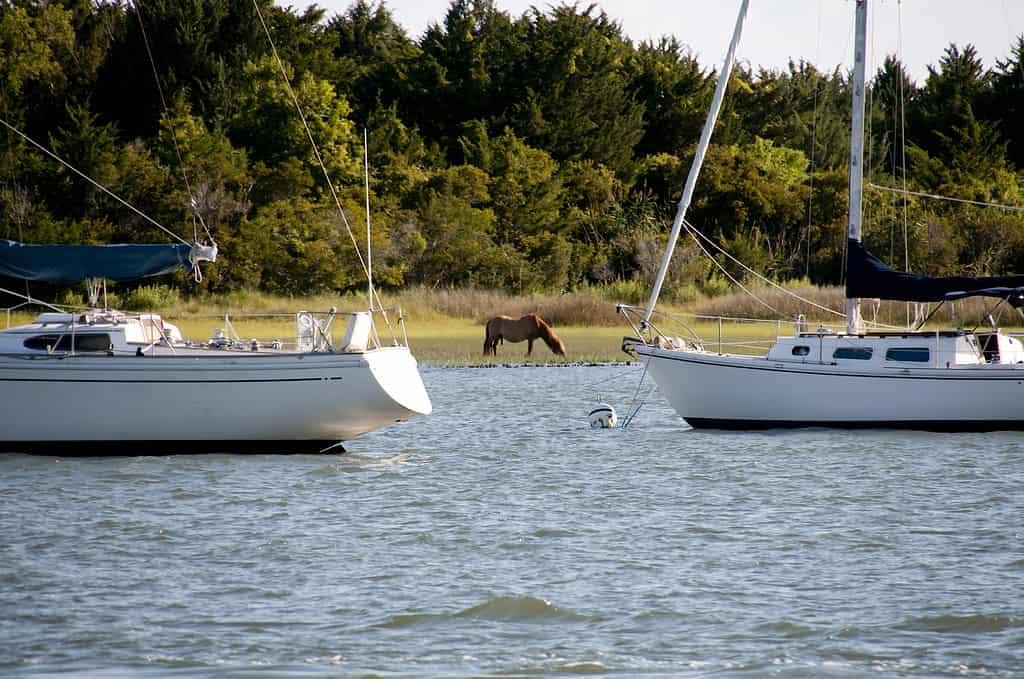
Wild horse tours are available when you visit the Outer Banks in North Carolina. These tours help you catch a glimpse of the wild horses who live on the islands.
©Robert Byron/iStock via Getty Images
Tours take visitors out to see the wild horses from March through November, but peak season is normally July to August.
There are tours available on Corolla, Shackleford Banks, and the Rachel Carson Reserve (including Carrot Island). If possible, make reservations if you plan your visit during the summer months. The Outer Banks is a popular vacation destination for tourists across the East Coast and beyond, so tours fill up quickly.
Thank you for reading! Have some feedback for us? Contact the AZ Animals editorial team.





